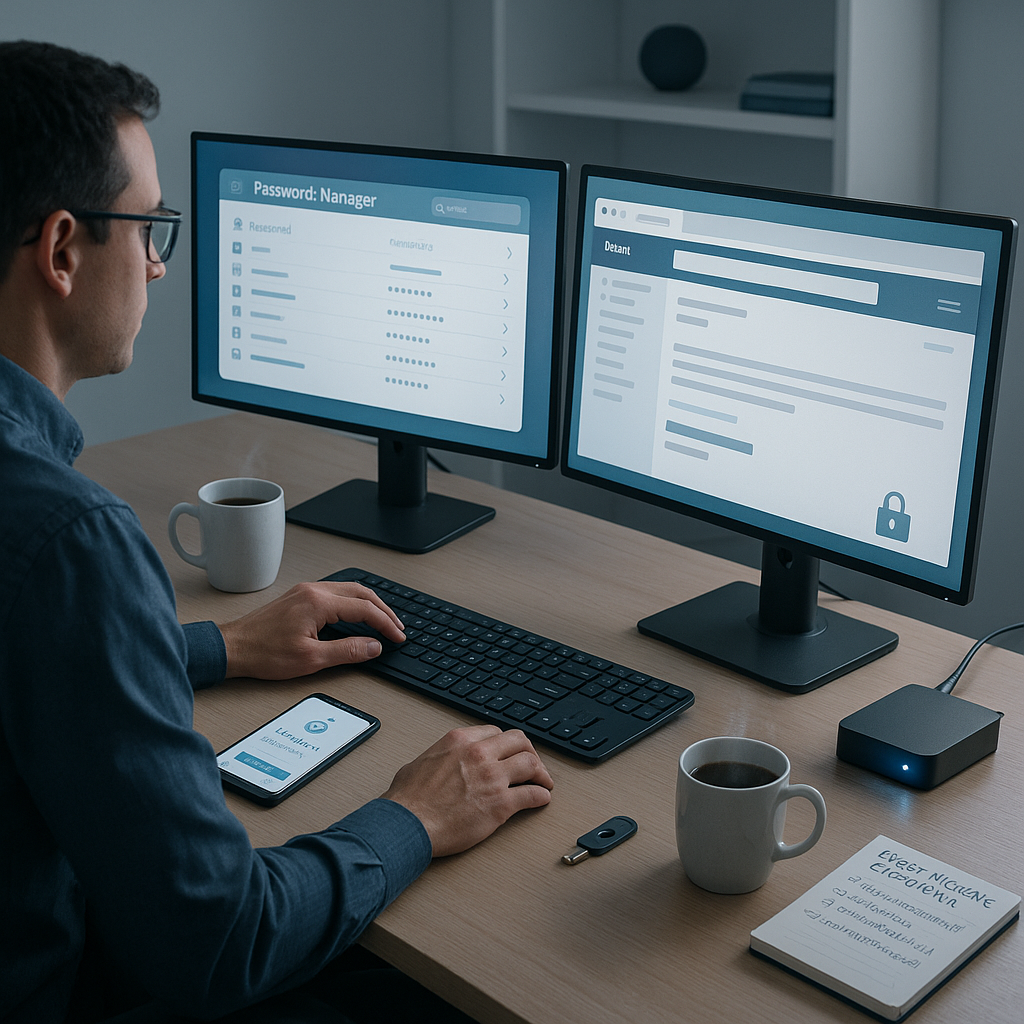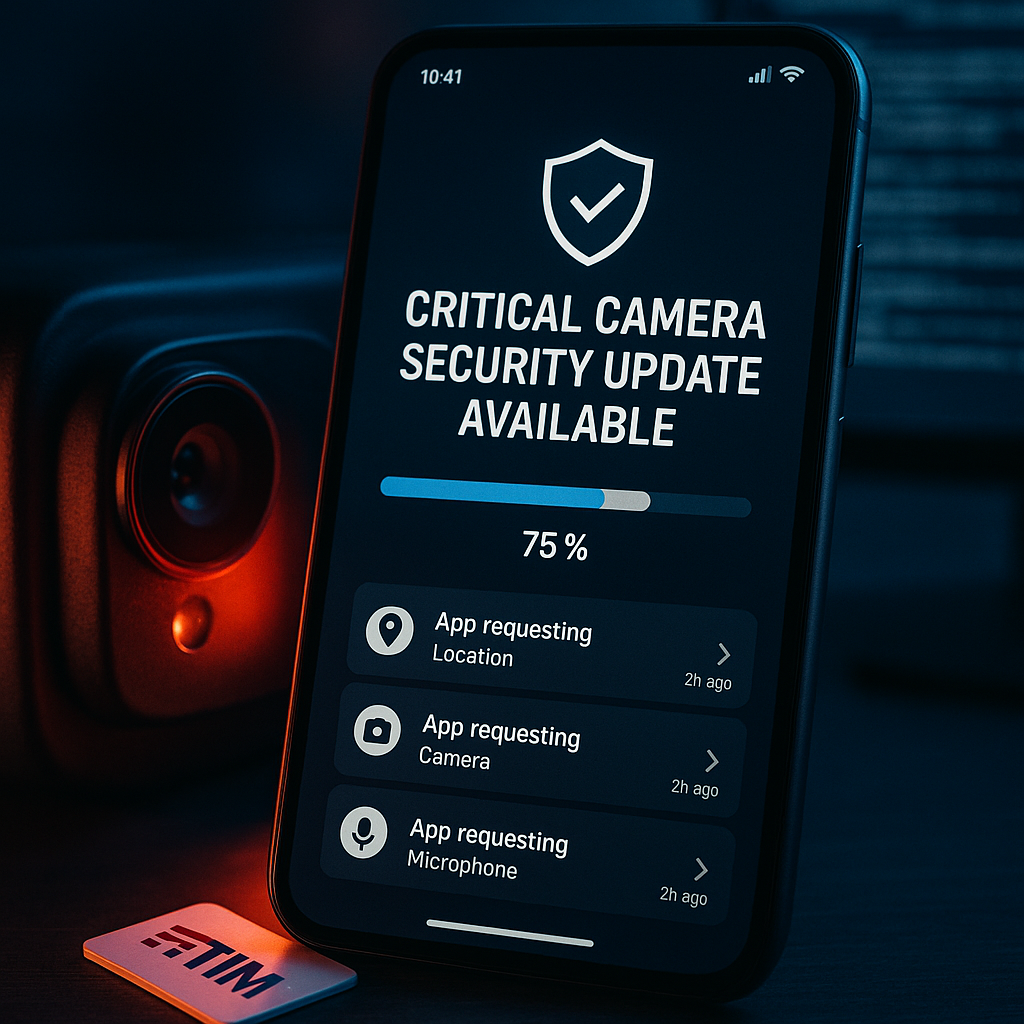Key Takeaways
- Stack new habits onto your daily routine for lasting security: Layering security practices, such as checking for suspicious emails or updating apps, onto existing habits (like your morning coffee) helps make digital protection truly automatic.
- Password management made effortless with smart tools: Use password managers to generate, store, and autofill unique credentials everywhere. This eliminates risky repeats and weak passwords, ensuring each account stays protected.
- Double down on safety with multi-factor authentication: Enabling MFA on all key accounts adds a vital layer, blocking most unauthorized access even if credentials are leaked.
- Stay one step ahead by updating software daily: Make checking for software and app updates a quick habit. Patched systems shut out the vast majority of common cyber attacks, securing your digital environment.
- Backups aren’t just for IT pros; automate and relax: Set up automatic cloud or external backups for important files, so you’re prepared for hardware failures, ransomware, or accidental deletions without thinking twice.
- Train your eye to spot and avoid phishing traps: Cultivate a quick “pause and inspect” habit before clicking email links or entering credentials. Suspicious language, URLs, or urgent requests are top red flags to watch for.
- Protect every device, not just your computer: Regularly update your phone and tablet, use device locks, and enable features like remote wipe to secure your entire digital life (not just your PC).
- Behavior change drives better security than technical know-how alone: Lasting safety comes from making small cyber habits stick, using simple cues and routines. Proven behavior change techniques outperform relying on willpower or technical fixes.
By weaving these actionable habits into your day, online safety naturally becomes part of your lifestyle. Now, let’s dive deeper into each step so you can build your own cyber hygiene checklist and stay protected, one simple action at a time.
Introduction
Many people lock their front doors without a second thought, but digital life requires more than a simple latch. The key to modern security isn’t just in using complex passwords or installing security apps. It’s in embedding small, proactive habits throughout your daily routines.
Building these digital habits is not just wise. It’s essential for shielding personal data, securing accounts, and safeguarding devices from rapidly evolving cyber threats. By incorporating quick security checks (such as updating software or pausing before clicking suspicious links) into your daily schedule, you turn online safety into an instinct.
This guide breaks down the ultimate cyber hygiene checklist, offering seven straightforward habits you can adopt today for stronger, stress-free online protection.
Un passo avanti. Sempre.
Unisciti al nostro canale Telegram per ricevere
aggiornamenti mirati, notizie selezionate e contenuti che fanno davvero la differenza.
Zero distrazioni, solo ciò che conta.
 Entra nel Canale
Entra nel Canale
Essential Cyber Hygiene Practices
Password Management and Security
Robust password management lays the groundwork for effective cyber hygiene. Instead of dreading password updates, fold them into existing routines. For example, pair password reviews with monthly bill payments. When you settle a utility, update a set of passwords at the same time.
Key Password Practices:
- Use easy-to-remember but strong passphrases (like “CoffeeBreakAt3pm!” instead of complicated random strings)
- Employ unique passwords for every account, utilizing a trusted password manager for storage and autofill
- Activate password breach alerts from platforms such as HaveIBeenPwned to stay promptly informed
Industry reports show that systematic password management reduces security incidents by nearly half. Tools like LastPass, 1Password, or Bitwarden make it easy for individuals and businesses alike, automating what was once a tedious process.
These principles have applications in fields like healthcare, where safeguarding patient portals is critical, and education, where digital classroom accounts need streamlined yet secure access.
Multi-Factor Authentication (MFA)
Adding a second step to your logins is akin to putting a deadbolt on your virtual doors. MFA no longer needs to be intimidating, thanks to user-friendly apps that streamline the process. Microsoft’s security team found that MFA can block up to 99.9% of account compromise attempts.
Simple MFA Implementation:
- Begin with sensitive accounts in finance, work, healthcare, and personal communications.
- Favor authenticator apps over SMS wherever feasible for added resilience.
- Securely store backup codes offline for emergencies.
Consider incorporating MFA checks with another habit; for instance, check your authenticator app as you prep your morning coffee. This routine creates a natural, daily reminder to ensure your protection is active.
Industries such as finance rely on MFA for account integrity, while legal firms use it to keep confidential information out of the wrong hands.
Software Updates and Patch Management
Patching is digital self-care. Routine updates close loopholes cybercriminals eagerly exploit. Establish a “Tech Tuesday” when you check for updates across your devices during lunch or a downtime moment.
Effective Update Management:
- Enable automatic updates for operating systems and key applications
- Set reminders for periodic manual checks on software that manages sensitive data (such as banking or healthcare apps)
- Keep a digital record or app inventory so nothing slips through the cracks
Research shows organizations prioritizing regular patching reduce vulnerabilities by more than 80%. Even as an individual, allocating 10 minutes a week to updates can prevent headaches ranging from malware infections in small businesses to patient data breaches in healthcare.
Education and government sectors, both heavily targeted by cyber threats, benefit immensely from regular, structured updates.
Data Backup and Recovery
Backing up files used to be a chore, but automatic options now make it simple. Adopt the “3-2-1 rule”: three copies, on two different types of media, with one off-site.
Practical Backup Strategy:
Un passo avanti. Sempre.
Unisciti al nostro canale Telegram per ricevere
aggiornamenti mirati, notizie selezionate e contenuti che fanno davvero la differenza.
Zero distrazioni, solo ciò che conta.
 Entra nel Canale
Entra nel Canale
- Schedule daily automated cloud backups for critical documents and photos
- Complete weekly backups to an external hard drive or secure specialist device
- Review and prune outdated files once every quarter to streamline storage
Make it routine; review backup status while you enjoy your Sunday breakfast, keeping your peace of mind on autopilot. Having reliable backups is equally vital for medical records in healthcare, transaction data in finance, and coursework in education.
Safe Browsing and Download Practices
A vigilant approach to browsing protects you against phishing, malware, and scams. With email remaining a top vector for attacks, focus on developing strong, mindful habits online.
Daily Safe Browsing Habits:
- Confirm website security certificates (look for “https” and verified padlocks) before entering sensitive information
- Use browser bookmarks for trusted sites rather than following links from emails
- Install vetted ad-blockers and privacy-focused extensions for a safer web experience
Before downloading, pause and ask: “Is this a trusted source? Did I intend to download this file?” This simple pause can block malware in everything from retail platforms to government service portals.
Your Daily Cyber Hygiene Checklist
Success in cybersecurity comes from making these routines second nature. Use this progressive checklist to layer habits throughout the day until they require little conscious effort:
Morning Routine:
- Review authentication app notifications over morning coffee
- Confirm backup status while checking news or emails
- Address security alerts alongside your inbox review
Workday Practices:
- Use a password manager for all logins and password autofill
- Scrutinize sender addresses and unexpected attachments
- Save vital files only in cloud-synced folders, not local downloads
Evening Security:
- Log out of sensitive platforms after use
- Clear browser histories and cache
- Recheck for pending device and app updates before shutting down
These steps fit seamlessly into all sorts of professional and personal environments, from classrooms where students handle assignments online to retail spaces managing inventory systems.
Overcoming Common Security Barriers
It’s common for people to feel that digital security takes too much effort or expertise. The reality is that perceived complexity, not true difficulty, holds most users back. Behavioral research reveals that tiny, regular actions are more powerful for change than trying to overhaul everything at once.
Barrier-Breaking Strategies:
- Start with one new habit each week, building confidence incrementally
- Employ subtle reminders, like digital sticky notes or daily calendar alerts
- Acknowledge and celebrate small wins; every phishing email you spot or password you upgrade is a victory
By tackling psychological barriers, both organizations and individuals foster a culture of security that endures. This approach translates well to sectors like environmental science, where compliance habits must become second nature, and marketing, where data privacy practices protect consumer trust.
Each step of this guide builds on the previous, creating a logical roadmap for sustainable cyber hygiene that naturally fits your lifestyle.
Conclusion
Adopting strong cyber hygiene practices is an investment in both peace of mind and long-term digital wellbeing. True online safety stems not from complicated technical fixes, but from simple routines that you can reliably maintain. Integrating password management, multi-factor authentication, regular backups, and software updates into your daily life creates a proactive defense that guards against threats across all your devices and accounts.
Looking ahead, developing adaptable habits and embracing proactive routines will become even more crucial as technology evolves and cyber threats become increasingly sophisticated. Whether you are managing personal finances, overseeing patient data, guiding students online, or shopping safely, these habits empower you to stay a step ahead. The most secure digital lives will belong to those who see security not as an occasional chore, but as an integral, instinctive part of daily living. Now is the moment to choose your first habit and start the cycle. True cyber resilience grows through smart, persistent action every day.





Leave a Reply